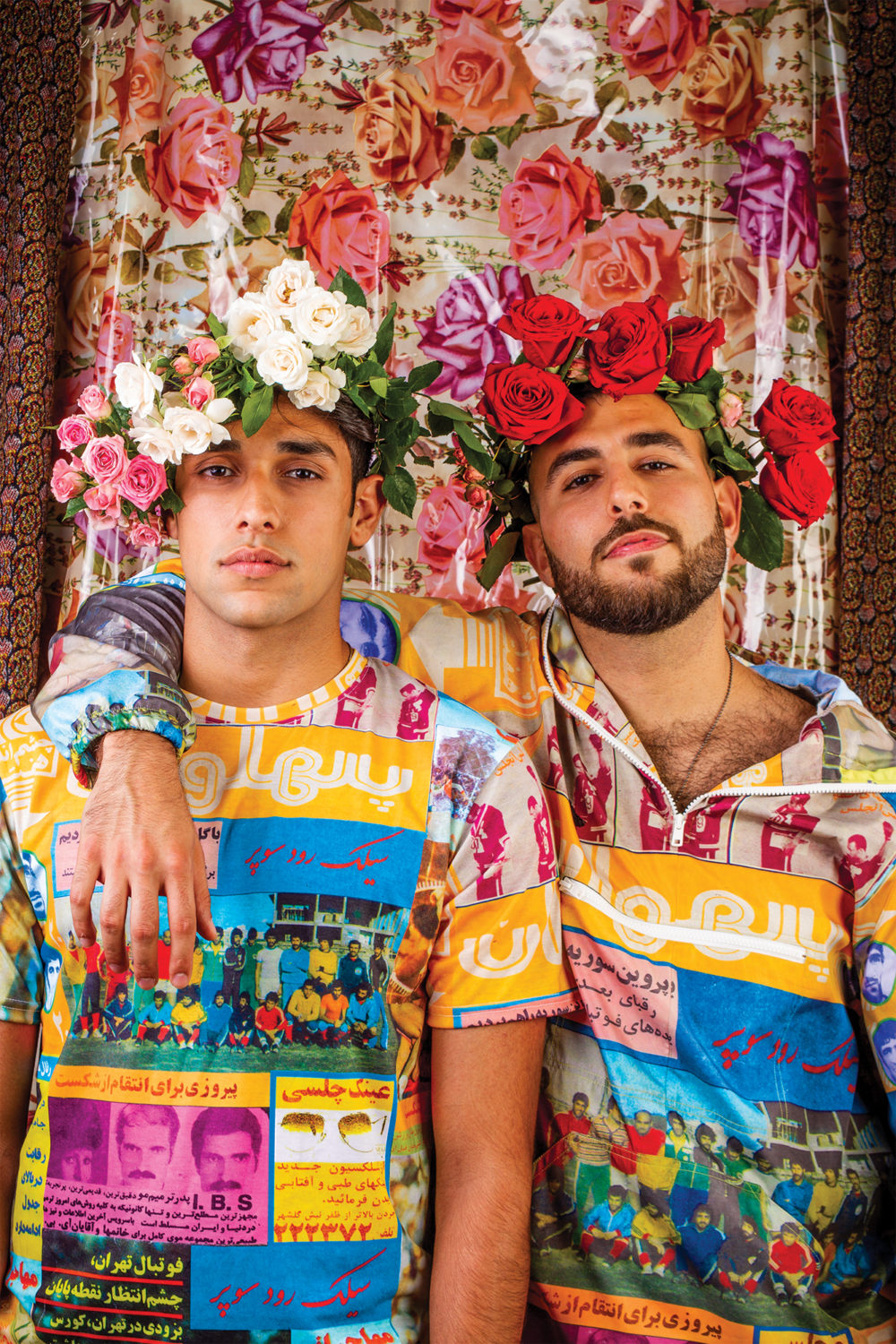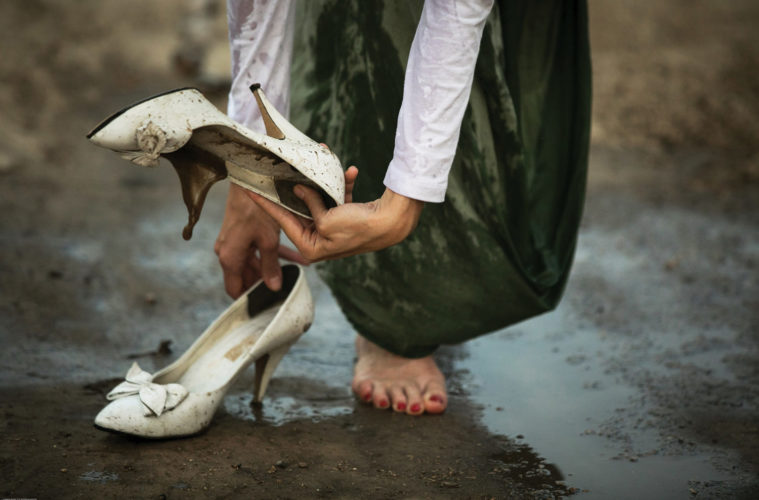In a stirring voice, Focus Iran 3 pushes back against homophobia and patriarchy in many of the 43 photo and video installations currently on display at UC Irvine’s Viewpoint Gallery. With a subtler voice, the Farhang Foundation exhibit challenges xenophobia, current U.S.-Iran relations and the ways in which Iranians are stereotyped by Westerners, and even by one another.
“There are a lot of messages in each image,” says Farhang executive director Alireza Ardekani, from the “homoerotic” to “a kind of uprising against the hijab.” The theme selected by the L.A.-based foundation is Iranian youth culture — the secondary themes, the “messages” as Ardekani calls them, come from the artists themselves.

Hushi Mortezaie & Jiyan Zandi – Photo courtesy of Focus Iran 3 exhibition.
Winning top prize at the exhibit, collaborators Hushidar Mortezaie and Jiyan Zandi, both from L.A., offer a message of unity in “The Brotherhood.” The photo presents a “new, progressive narrative” of Iran and the region, Zandi says, one that embraces multiculturalism, gender fluidity and the LGBTQ community. The image shows two men wearing matching shirts with collages created by Mortezaie from 1970s news, sports and pop culture media clippings. They pose — one man with his arm proudly draped over the other’s shoulder — in contradiction to 1970s’ machismo, the floral backdrop and rose crowns resting on the men’s heads aiding the juxtaposition. This work, she says, “is a chance to tell an untold story about marginalized identities and portray a brighter, more inclusive future.”
Irvine-based photographer Hadi Safari also works to highlight marginalized identities. Safari, who moved to the U.S. in 2015 and spoke through an interpreter, says his work looks to document the rituals of cultural and ethnic minorities around the world. “The Holy Healing Pole,” which appears at Focus Iran 3, depicts a young man climbing a wooden pole in a deserted landscape. The black-and-white photo is capturing an Iranian Turkmen superstition for good health.
Juried by a multinational panel of celebrated photographers and curators, Focus Iran looks to create a level playing field where artists from around the world can share their work with the international community. “We wanted to make something that is very democratic, especially for artists inside Iran,” Ardekani says. The exhibit showcases digital mediums so that anyone with access to the Internet, or even a smartphone, would be able to participate.

Sanaz Khosravi – Photo courtesy of Focus Iran 3 exhibition.
Now in its third installation, Focus Iran began in 2015 and shows every other year. While the exhibition is open to all photographers regardless of race, ethnicity or nationality, roughly 80 percent of this year’s approximately 300 submissions came from inside Iran, according to Ardekani, and provides the artists with unique opportunities. For example, third prize-winning “The Kiss” would not be able to show in Iran where artist Milad Karamooz lives, Ardekani says. The image depicts a man wearing a bondage-style black lace harness lovingly clutching the arms of a man who stands shirtless behind him, donning black leather gloves and holding battered shears to the first man’s lips. With no contextual background, the photo may appear gratuitous — an over-the-top image for the sake of being over the top. Yet, its deep significance is revealed in the realization that the work is likely a stinging indictment of draconian LGBTQ policies in Iran, a country where Karamooz risks his own safety daily. Ardekani says that Focus Iran 3 not only provided Karamooz a veritable platform to voice his struggle, it also gave him “hope” in his significance as an artist and LGBTQ activist.
Politics on this side of the globe have had their own effects on Focus Iran 3, Ardekani acknowledges. Karamooz and all other exhibiting artists from Iran who planned to attend were denied visas “due to what they call the ‘Muslim ban,’” he says.

Seyed Shahabeddin Montazeri – Photo courtesy of Focus Iran 3 exhibition.
Despite this, Ardekani sees the exhibition as a community-building platform. Beyond opening a conversation between artist and audience on an international level, it also allows Iranian expatriates and those in the second generation an unfiltered, new look at Iran and its views, views so insubordinate that many Iranian Americans are surprised, he says.
Additionally, Focus Iran builds community by connecting local artists, he says — pointing to the collaboration by L.A. artists Labkhand Olfatmanesh and Gazelle Samizay who won this year’s second prize. The two met as exhibiting artists during Focus Iran 2 and created a video together for this year’s submission.
A haunting six-minute film, “Bepar” examines the effects of male dominance on society in terms of war and female subjugation. In the video, a young woman plays hopscotch while encountering bombings and familial control. Born and raised in Iran, Olfatmanesh lived in Orange County for some years after immigrating to the U.S. in 2006. She says she connected easily with Samizay, who is Afghan and grew up in the U.S. “War, in particular, had an effect on both of us and our families,” she says, referring to their respective experiences, the Iran-Iraq War and the Soviet invasion of Afghanistan.
“Bepar” is soaked with symbolism: Berries that look like blood drip from the mouth of a female character while another wears wedding shoes far too large for her — an implication of societal pressures cast upon women and girls in some communities.
Yet, Samizay points out, far from media reports that depict these cultures as one-dimensional, the reality is much more complex. “I think it’s very easy for people to think in that part of the world that’s just the way it is — that women are oppressed, period,” she says. “We tried to show it’s more complicated — that war has an effect on families, that interpersonal relationships have an effect, there are all these different things,” she says. “And, as human beings, no matter what culture you’re in, you kind of have to find your own path and navigate all of that.”
Viewpoint Gallery, Student Center, UC Irvine, 311 W. Peltason Drive, Irvine. free; open daily: 7 a.m.-midnight, Oct. 5 – Nov. 6. (949) 824-5252, studentcenter.uci.edu/viewpoint-gallery.
Advertising disclosure: We may receive compensation for some of the links in our stories. Thank you for supporting Irvine Weekly and our advertisers.

